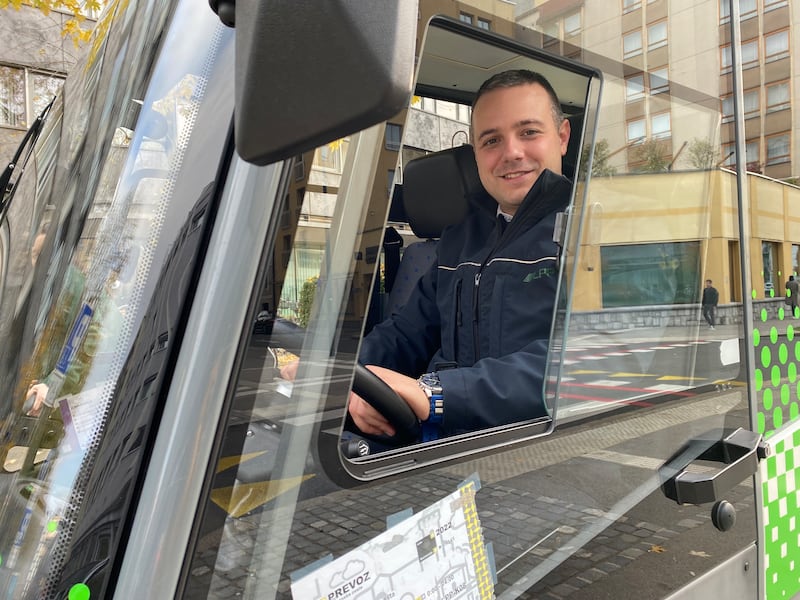The electric gentlemen of Ljubljana pootle around the Slovenian capital at speeds of about 6kmh – slow enough for a pedestrian to hail one at ease.
These small vehicles ply the historic town’s core and are one answer to the question: if you pedestrianise a whole city centre, what do you do for people with mobility issues?
Kavalirs, or gentlemen, sort of resemble Dublin City Council street sweepers but without all the cleaning apparatus. They can comfortably seat five passengers, four in the back and one up front with the driver. You see them in the Baroque old town, ferrying people about, their distinctive electric hum audible on the otherwise traffic-free streets.
I, my partner and our nine-month-old son decided to hail one on Stritarjeva ulica for a free ride to the Metelkova Art Centre, 1.4km away. The driver, a friendly man named Bojan Vidovic, said our destination was outside the pedestrianised area and, thus, outside his range – but he could take us some of the way. Good enough. We hopped in.
Vehicular traffic once dominated Ljubljana. “The city centre used to be packed with cars and buses,” says the Ljubljana European Green Capital 2016 report. “Today it is reserved for cyclists and pedestrians.”
The kavalirs (the word can also mean gentle helper) were introduced in 2008 as part of Vision 2025, a sustainability programme that included the pedestrianisation of most of the city centre.
About 30 seconds into our trip, an elderly man holding a crutch and some shopping bags hails our vehicle at The Triple Bridge which connects the medieval town with the modern city. He sits in and starts chatting with Vidovic.
“We are just taking this gentleman to the station because he can hardly walk,” says Vidovic, turning to address us in the back.
The 300m detour takes about three minutes; driver and passenger chat amiably the whole way until Vidovic pulls up at a bus stop on Slovenska cesta and the man steps out with his shopping, full of thanks.
Vidovic says the kavalirs were initially intended for older people “and people with disabilities and parents with little children. Then we spread it to everyone.” You still get the impression that it’s mostly older people who use them though.
At first there was just one kavalir and, because it was a glorified golf cart, it only operated during the warmer months. The fleet has since expanded to six vehicles (including closed ones for winter) and operates year-round, every day of the week, including Sundays, when almost nothing else in this town seems to operate.
“It was just the mayor’s idea to have something for the old people,” says Vidovic. The mayor in question is Zoran Janković, a Serbian-Slovenian businessman who was first elected in 2006. He immediately implemented Vision 2025, a scheme to improve green areas, public transport, waste management and pedestrianisation.

The move to ban private cars from the city centre met resistance at first. “People didn’t want it,” says Vidovic. “But now they are used to it. They don’t hear so many buses through Prešeren Square. Now we cannot imagine that before there was traffic through the city. I think it’s better.”
The ban closed more than 100,000sq m of the city centre to cars and led to an increase in pedestrian surfaces of 620 per cent. It also contributed to a reduction in black carbon emissions of 70 per cent in some areas while noise levels dropped by 6dB.
Last month Ljubljana, a city of 300,000, was the only capital to be shortlisted for the European Commission’s 2023 Access Award (won by the Swedish city of Skellefteå) for cities which have prioritised accessibility for people with disabilities. Mayor Janković has been re-elected several times.
Vidovic drops us off at Tavcarjeva ulica, about 500m from where he picked us up. “This is the farthest that I can take you,” he says. The journey, including the detour for the man who actually needed the kavalir, has taken about seven minutes.
A message from the mayor, pasted to the side of our vehicle, informs us a team of 19 “responsible and polished” kavalir drivers now provide more than 10,000 passenger journeys a month. They received the Ljubljana Award for 2022 for the service they provided during the coronavirus pandemic.
“It’s nice when you help someone who cannot go alone here in the city,” says Vidovic as we idle on the street. “When they say to you ‘thank you’, that fills you up with new energy. It’s nice. And it’s flexible. You don’t sit eight hours a day like you can on a computer. There’s always something happening, you know, it’s interesting. The time goes fast and if you know that you can help someone and he’s thankful to you, it’s a big plus.”











